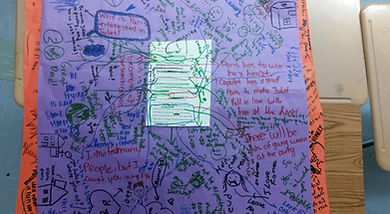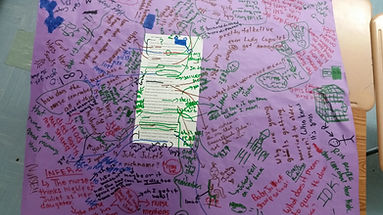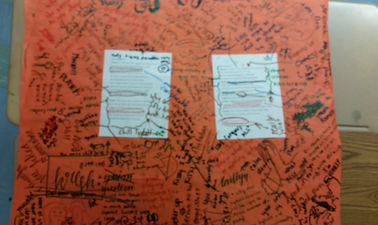
Lesson on Irony
Students were given a brief explanation of the three major forms of irony: verbal, situational, and dramatic. Once the students had taken their notes, they were then given a card with these terms written at either end. I then read short scenarios where one of these ironies was in play. Once read, the students then lifted their card to reveal the type of irony they’d observed.
This formative assessment is quick, informative, and the kids have fun with it. After the lesson, students read Edgar Allan Poe’s The Cask of Amontillado and were asked to analyze the role irony played in the plot of the story in an open-ended response. Students were able to collaborate and help each other during this process. Many referred back to the lesson’s scenarios when discussing how these three ironies worked.
Romeo and Juliet Write-Around!
Inspired by The Unquiet Librarian, I have provided you six select passages from Romeo and Juliet for a text write-around. Using your marker and your mind, you will silently annotate the text to demonstrate comprehension, ask questions, share ideas, and engage each other in a dialogue about the material. Have fun!


Types of annotation you will explore today:
Questions: may include questions about plot, character, author intent
Opinions: may include judgements, assessments, reactions to characters and events
Response to Text: may include text analysis, identification of literary devices (metaphors, similes, puns, symbolism, etc.), observations, character analysis, and connections you make between this text, yourself, and/or outside texts
Peer Response: React to what other students have written, ask questions, answer questions, extend the conversation
Drawing/Graphic: may include reactions through image, metacognitive responses, image inspired by text.
Off topic: You may stray from the topic, free associate



You all did an amazing job annotating Act 1 of Romeo and Juliet. Here are just a handful of the open-ended questions your groups came up with for your Act 1 quiz. Your analysis of the text will go a long way in answering these very challenging questions.
Student Generated Open-Ended Questions:
-
What does the prologue foreshadow about the story to follow? What effect does the prologue have on the reader? Use cited evidence.
-
Define one theme in the play that is established in Act 1, Scene 1.
-
Describe the “ancient feud” between the Montagues and the Capulets and how does it affect the characters and the townspeople of Verona?
-
Describe Mercutio’s character based on his monologue.Who is Queen Mab and why is Mercutio talking about her?
-
Compare and contrast Juliet’s relationship with her mother to that of the Nurse.
-
What character is the most memorable and relatable person to you? Describe this character and make personal connections to them. Use evidence from the text to make your connections
-
What can you tell of Juliet’s relationship with her Nurse? Do you think the nurse will support Juliet and Romeo’s newly found love or restrain them from seeing each other. Use evidence form the text to support you answer.
-
You have read ACT 1 of Romeo and Juliet and know that Romeo changes his mind quickly. Describe the “love at first sight” moment between Romeo and Juliet in scene 5. Explain why Romeo falling in love with Juliet so quickly is dangerous. Use that as supporting evidence.
Write-Arounds for 106 and 108
Prologue


Act 1 Scene 1


Lord Capulet Monologue


Nurse Monologue


Mercutio Monologue


Act 1 Scene 5


Instagram Character Analysis: R+J
Round 1
-
You have selected a character from R+J
-
Give this character a profile pic
-
Choose an image you believe the character would have on their Instagram account
-
Choose one quote from your character in the play to act as a comment to your character's image
-
Choose three hashtags your character would apply to their image
Round 2
-
Rotate the room and comment on other characters "accounts" as your character.
-
Use at least three quotes from the play
